The staff and research assistants at the Primate and Predator Project has been busy. I wanted to slow down and share some of our updates.
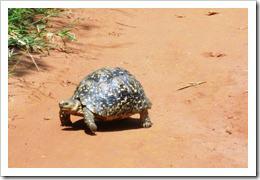
Research Assistant projects
All of the project research assistants contribute to the huge on-going datasets we need to collect. Some of them are also completing internship programmes as part of university degrees and during their time here they also need to conduct their own small research projects. We help to supervise these projects and depending on the nature of the project, it may be research that we can add data to in the future to use towards publications.
At the moment we have several students working on projects. Mira from Van Hall Larenstein University in the Netherlands is investigating whether vegetation characteristics affect sleeping site selection in samango monkeys.
She has been gathering a lot of habitat data by setting up vegetation plots around sleeping sites which are used by both troops. This data is compared with sleeping sites which have been historically used, but are no longer occupied.
Here is Mira navigating with the GPS to her sites and measuring tree circumferences:
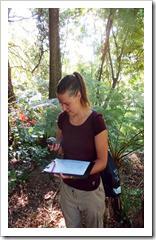
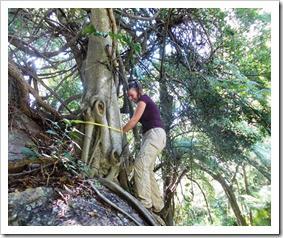
Kaja, also from Van Hall Larenstein University, is testing how samango monkeys react to the color red. Red can often be a threatening or dominating color in nature. During follow days she wears either a bright red or a bright blue t-shirt and is taking focal data on individual samango monkey responses to these stimuli.
Here’s Kaja in red following the monkeys with some of the Earthwatch volunteers:

Sophie from Cardiff University in Wales is working with the PPP for ten months as part of her year in industry and is studying whether leopards alter their behavior in response to hunting. She is comparing camera trap images of leopards taken on a property used for hunting and a neighbouring reserve where no hunting is conducted. She will also be analysing changes in leopard activity on the hunting property during hunting season and non-hunting season. Sophie is currently writing her own blog post about her work which will be up soon so I won’t give away too much information!
Office opening party
In December the project office was completed and we were able to move in! The project finally has a designated space to keep our equipment and to work quietly. The newly installed solar system provides us with reliable environmentally friendly power.
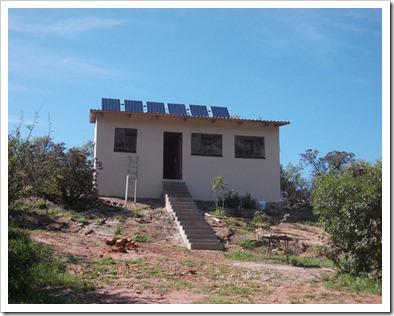
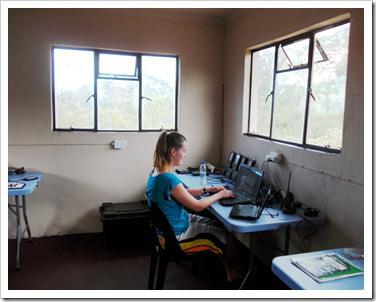
But all this didn’t happen without a lot of hard work and manual labor. Ian, Oldrich, Robert, Ticha and Ephraim have worked incredibly hard to build the office and the other new additions to Bush Camp like the safari tens. On the evening of Jan 25th we had an office opening braai (a South African barbeque) to say thank you.
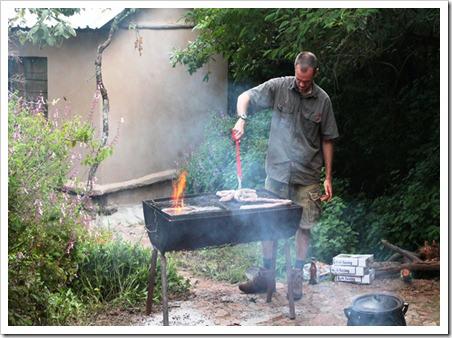

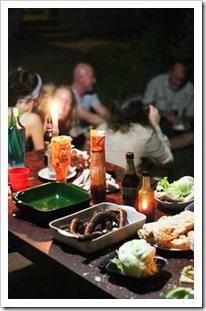
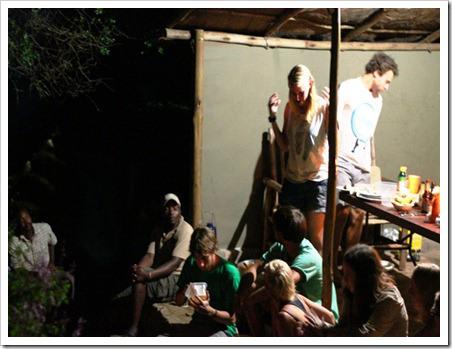
Publications
Two new academic papers have been published recently by Primate and Predator Project researchers and PPP Principal Investigator, Russell Hill.
Ben Coleman and Russell Hill published in Animal Behaviour based on the landscapes of fear Ben created during his PhD research. A “landscape of fear” is a space where a prey species perceives higher predation risk (Laundre et al., 2001). This was achieved by mapping the eagle specific alarm calls and the inter-group encounters of the samango group he followed. With some (relatively) fancy stats Ben was able to conclude that the samangos avoid areas they perceive to be of high eagle risk even though there might be other resources in there (Coleman, 2014).To access the abstract click here.
Data from 2008 on leopard density in the area became publically available this year through the publication of an academic paper in the open access journal, PLoS One. Dr Julia Chase Grey is the lead author of Evidence of high density population of harvested leopards in a montane environment which concludes that leopard density in the western Soutpansberg Mountains is 10.73 adult leopards per 100 km2. This is the highest adult leopard population density recorded outside of state-protected areas in Africa. This case study indicated that mountainous and mostly privately owned land is a vital habitat for leopards and must be prioritised in large carnivore conservation (Chase Grey et al., 2013). This paper can be downloaded in full as a PDF for free from here.
Earthwatch January 2014
In January we hosted a great Earthwatch team. We had four local team members from South Africa who attended through Earthwatch’s Community Fellow programme and two international volunteers.
Three of the Community Fellows were graduate students at the University of Limpopo. Here is David and Deo having fun after a long day out in the field.

One of the neighbouring properties to Lajuma is battling to control eucalyptus trees, an invasive species. We volunteered our January Earthwatch team as helpers. They spent a day checking our nearby camera traps and killing eucalyptus trees to allow native species to recolonize. It was a very productive day which was of great benefit to conservation and also a nice way to improve neighbor relations.

The Earthwatch team also participated in the WESSA Eco-schools programme that Judy leads. The children loved meeting local and international volunteers and learning about the environment from them.
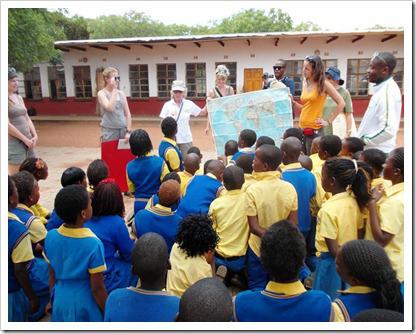
We climbed Mount Lajuma on the last day. Here is Given and Hilonipho looking out over all the places they had been working for the past week.
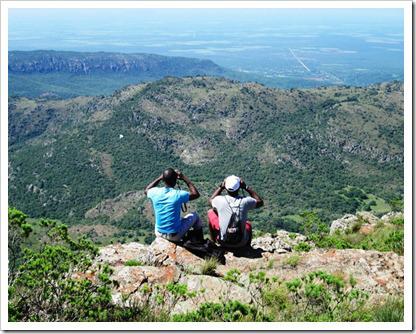
I’d like to tell a personal story from this Earthwatch group about Given. Given has been working for me since December as my translator for the interviews I am conducting on brown hyaenas in the small local community near the base of the Soutpansberg Mountains where he lives. I invited him to join the Earthwatch team as a Community Fellow so that he could learn more about the area he lives in and also so he could better understand why I am doing my PhD and the interviews. After Earthwatch finished in January I spent another day with Given conducting interviews in his community. He had a completely different take on the work than before joining Earthwatch. When we went around to see interviewees he was able to explain in great detail about the research. He would excitedly tell them all about the animals in the mountains, our camera trapping work, and the things he learned. His enthusiasm for wildlife had increased immensely. Throughout the day he told me at least five times how much he missed Lajuma. Even though he is the most local person we have ever had join Earthwatch, I think it was an completely eye opening experience for him and the fact that this experience will hopefully not only affect him but also the local community where lives is fantastic.
Here’s Given ‘flying high’ during Earthwatch while visiting Madiathavha cultural center on our day off:
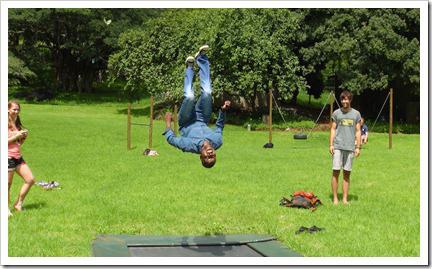
We tweet! The Primate and Predator Project is on Twitter now so please follow us @PrimatePredator.
- Katy Williams, PPP Field Team Leader
Thanks to David Kunutu for many of the photos included in this blog
References:
Chase Grey, J.N., Kent, V.T. and Hill, R.A. (2013) Evidence of a High Density Population of Harvested Leopards in a Montane Environment. PLoS ONE 8 (12), 1 – 11.
Coleman, B.T. and Hill, R.A. (2014) Living in a landscape of fear: the impact of predation, resource availability and habitat structure on primate range use. Animal Behaviour 88, 165 – 173.
Laundre, J.W., Hernandez, L. and Altendorf, K.B. (2001) Wolves, elk, and bison: reestablishing the "landscape of fear" in Yellowstone National Park, USA. Canadian Journal of Zoology-Revue Canadienne De Zoologie 79, 1401-1409.
